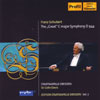Schubert Symphony No 9
No rocking the Schubert boat by Sir Colin in a striking ‘Great’
View record and artist detailsRecord and Artist Details
Composer or Director: Franz Schubert
Genre:
Orchestral
Label: Profil
Magazine Review Date: 13/2006
Media Format: CD or Download
Media Runtime: 51
Mastering:
Stereo
DDD
Catalogue Number: PH06038

Tracks:
| Composition | Artist Credit |
|---|---|
| Symphony No. 9, 'Great' |
Franz Schubert, Composer
Colin Davis, Conductor Franz Schubert, Composer Staatskapelle Dresden |
Author: Nalen Anthoni
You could call this performance “traditional”, though Mahler’s belief in tradition as a collection of bad habits isn’t sustained. Certainly Colin Davis follows the tradition – hardly bad – of omitting the repeats in the outer movements and those in the second halves of the Scherzo and Trio. But the habit of speeding up the Andante introduction to the first movement to match the transition to the main Allegro – at best questionable because it softens the differences between the two sections – is rejected. Davis keeps the tempo steady until directed; the change thus becomes more dramatic. And he rejects the bad habit of pulling back the coda towards the end so that it grinds to a halt. Instead he builds the tension continuously, only broadening the last chords.
What is traditional is the combination of weightiness and sagacity, so potently heard from the beginning, the introduction spacious but not stodgy, orchestral colours subtly delineated, instrumental balances spot on. The slow movement is particularly striking in this respect. The recording is not always ideally clear and the texture tends to become a trifle congested during dynamic moments; yet the atmosphere of a live event has been captured.
Adrian Boult took a largely similar view in his 1969 Proms performance; and, of course, there are other ways of re-creating this work, notably from Nikolaus Harnoncourt (who observes all repeats) and Simon Rattle. But Davis’s way, meticulously prepared, supremely well played, imposing yet flexible, puts this recording on an artistic pedestal.
What is traditional is the combination of weightiness and sagacity, so potently heard from the beginning, the introduction spacious but not stodgy, orchestral colours subtly delineated, instrumental balances spot on. The slow movement is particularly striking in this respect. The recording is not always ideally clear and the texture tends to become a trifle congested during dynamic moments; yet the atmosphere of a live event has been captured.
Adrian Boult took a largely similar view in his 1969 Proms performance; and, of course, there are other ways of re-creating this work, notably from Nikolaus Harnoncourt (who observes all repeats) and Simon Rattle. But Davis’s way, meticulously prepared, supremely well played, imposing yet flexible, puts this recording on an artistic pedestal.
Discover the world's largest classical music catalogue with Presto Music.

Gramophone Digital Club
- Digital Edition
- Digital Archive
- Reviews Database
- Full website access
From £8.75 / month
Subscribe
Gramophone Full Club
- Print Edition
- Digital Edition
- Digital Archive
- Reviews Database
- Full website access
From £11.00 / month
Subscribe
If you are a library, university or other organisation that would be interested in an institutional subscription to Gramophone please click here for further information.




